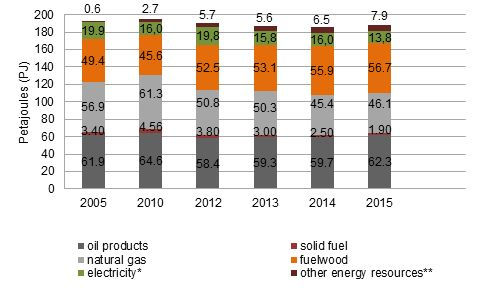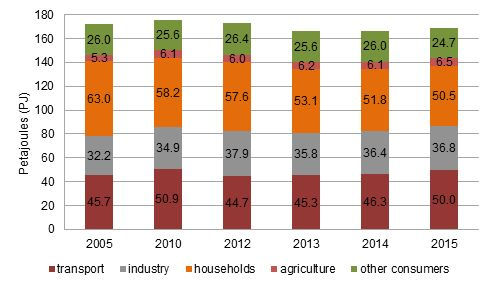Analytics, Energy, Latvia
International Internet Magazine. Baltic States news & analytics
Friday, 26.04.2024, 06:52
Transformation sector shows an increase in the share of renewables in Latvia
 Print version
Print version
During recent years the structure of energy consumption has changed – consumption of natural gas has decreased, however consumption of other energy resources, especially fuelwood, has increased, thus facilitating reduction in energy dependence (from 63.9% in 2005 to 40.6% in 2014). Over a period of ten years the share of natural gas in gross energy consumption has dropped by 5.3%, comprising 24.4% in 2015. Meanwhile, the share of fuelwood consumed has risen by 4.5%, reaching 30.2% in 2015. The gross consumption of other energy resources, including straw, biogas, and biofuel, increased from 0.7 PJ in 2005 to 8.0 PJ in 2015.
 |
| Gross energy consumption |
* Net imports of water power, wind
power and electricity
** Waste tyres, municipal waste for burning, charcoal, straw, other biomass,
biogas, biofuel
In 2015, 50.1 PJ of energy were consumed within the transformation sector for production of heat and electricity, and 38.2 PJ of energy (of which 25.5 PJ of heat and 12.7 PJ of electricity) were produced. In Latvia the production of heat and electricity in the transformation sector is mainly based on natural gas, however the share thereof is decreasing gradually – from 81.0% in 2010 to 64.3% in 2014 and to 63.5% last year. During a five-year period, the share of renewables (fuelwood, biogas and other biomass) consumed in the transformation sector increased by 19.8% and amounted to 36.1% in 2015.
No significant changes were recorded in final energy consumption over the past ten years. In 2015, final energy consumption in Latvia amounted to 168.5 PJ, which was 1.2% more than in 2014. The largest amount of energy is still being used up by households and transport, consuming 30% of energy resources on average. Consumption of energy resources in households tends to decrease – from 63.0 PJ in 2005 to 50.5 in 2015. At the same time, energy consumption in other sectors has grown.
 |
| Final energy consumption in Latvia, PJ |
In 2015, 50.0 PJ were consumed in the transport sector, which was 8.1% more than in 2014. Last year, the share of diesel oil in the transport sector amounted to 61.8%, which was 8.4% more than in 2014. The consumption of liquefied petroleum gas within the transport sector has increased by 171.7% over a period of five years – from 1 PJ in 2010 to 2.7 PJ in 2015. In 2015, the share of biodiesel and bioethanol in the transport sector amounted to 4.1% – 2.1% more than in 2014. Whereas motor petrol consumption in the transport sector decreased by 30.3% during the period from 2010 to 2015, amounting to 8.6 PJ in 2015.
In comparison to 2014, in 2015 consumption of energy resources in industry increased by 1.1% and amounted to 36.8 PJ. In 2015, the largest amount of energy resources was used in the manufacture of wood and of products of wood and cork – 18.9 PJ or 51.5% of final energy consumption in industry. In comparison to 2014, consumption of energy within the respective sector increased by 6.8%, as the volume of manufactured wood pellets also grew – by 14.1% (28.4 PJ). The bulk of wood pellets manufactured in Latvia is destined for export; in 2015 pellet exports accounted for 28.0 PJ, which was 20.4% more than in 2014. In 2015, the largest decrease in consumption of energy resources was observed in mining and quarrying – a fall of 31.1%.
In 2015, the total energy consumption in households amounted to 50.5 PJ, which was 2.6% less than in 2014. No notable changes may be observed in the structure of energy resource consumption in households, as they mostly use fuelwood (with 85% taken by firewood).
More detailed information on energy consumption in households will be available in the informative leaflet "Energy Balance in 2015" (only in Latvian) in August 2016.
Methodological explanations
Gross energy consumption includes the consumption of energy resources for production of heat and electricity (transformation sector), and final consumption, which includes all sectors of the national economy, as well as households.
Energy dependence is an indicator that is calculated by subtracting the volume of exports from the volume of imports of energy resources, and by dividing it with the total volume of energy consumption and adding bunkering.
Transformation sector (combined heat and power plants and heat plants) includes the volume of electricity and heat that is produced for sale.








 «The Baltic Course» Is Sold and Stays in Business!
«The Baltic Course» Is Sold and Stays in Business!

